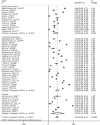A systematic review and meta-analysis on the prevalence of stigma in infectious diseases, including COVID-19: a call to action
- PMID: 34580416
- PMCID: PMC8475479
- DOI: 10.1038/s41380-021-01295-8
A systematic review and meta-analysis on the prevalence of stigma in infectious diseases, including COVID-19: a call to action
Abstract
Infectious diseases, including COVID-19, are crucial public health issues and may lead to considerable fear among the general public and stigmatization of, and discrimination against, specific populations. This meta-analysis aimed to estimate the pooled prevalence of stigma in infectious disease epidemics. We systematically searched PubMed, PsycINFO, Embase, MEDLINE, Web of Science, and Cochrane databases since inception to June 08, 2021, and reported the prevalence of stigma towards people with infectious diseases including SARS, H1N1, MERS, Zika, Ebola, and COVID-19. A total of 50 eligible articles were included that contributed 51 estimates of prevalence in 92722 participants. The overall pooled prevalence of stigma across all populations was 34% [95% CI: 28-40%], including enacted stigma (36% [95% CI: 28-44%]) and perceived stigma (31% [95% CI: 22-40%]). The prevalence of stigma in patients, community population, and health care workers, was 38% [95% CI: 12- 65%], 36% [95% CI: 28-45%], and 30% [95% CI: 20-40%], respectively. The prevalence of stigma in participants from low- and middle-income countries was 37% [95% CI: 29-45%], which is higher than that from high-income countries (27% [95% CI: 18-36%]) though this difference was not statistically significant. A similar trend of prevalence of stigma was also observed in individuals with lower education (47% [95% CI: 23-71%]) compared to higher education level (33% [95% CI: 23-4%]). These findings indicate that stigma is a significant public health concern, and effective and comprehensive interventions are needed to counteract the damaging effects of the infodemics during infectious disease epidemics, including COVID-19, and reduce infectious disease-related stigma.
© 2021. The Author(s), under exclusive licence to Springer Nature Limited.
Conflict of interest statement
The authors declare no competing interests.
Figures




References
-
- World Health Organization. Coronavirus Disease (COVID-19) pandemic. 2020. https://www.who.int/emergencies/diseases/novel-coronavirus-2019. Accessed 14 Dec 2020.
-
- Shi L, Lu ZA, Que JY, Huang XL, Liu L, Ran MS, et al. Prevalence of and risk factors associated with mental health symptoms among the general population in China during the Coronavirus Disease 2019 pandemic. JAMA Netw Open. 2020;3:e2014053. doi: 10.1001/jamanetworkopen.2020.14053. - DOI - PMC - PubMed
Publication types
MeSH terms
Grants and funding
LinkOut - more resources
Full Text Sources
Medical
Miscellaneous

